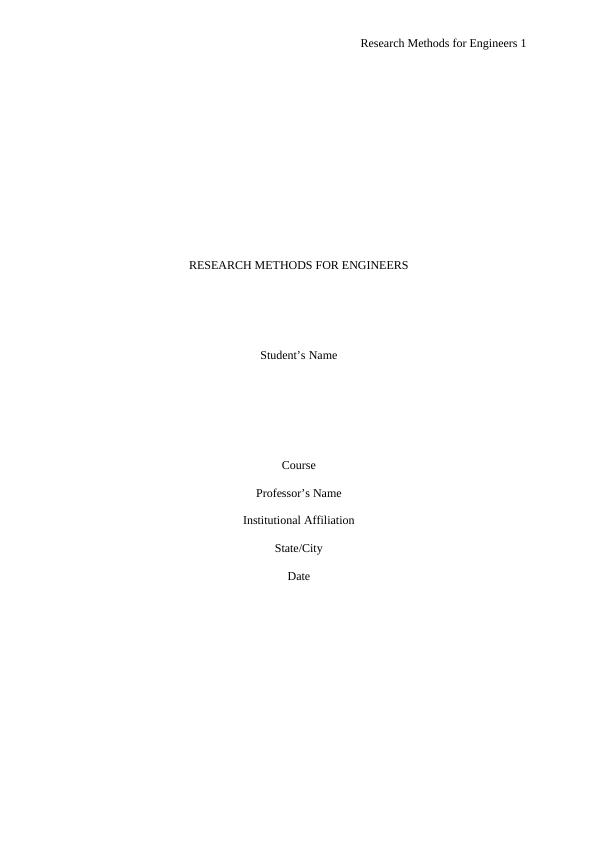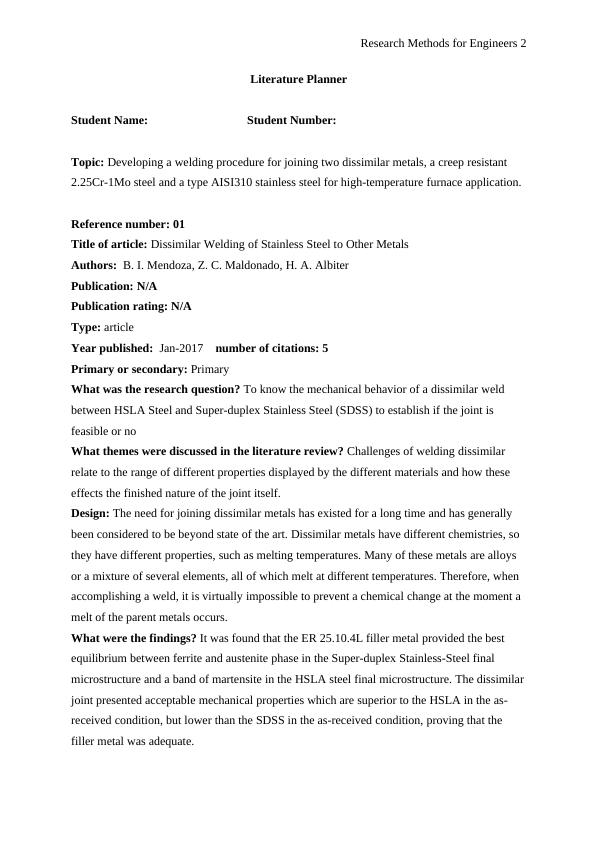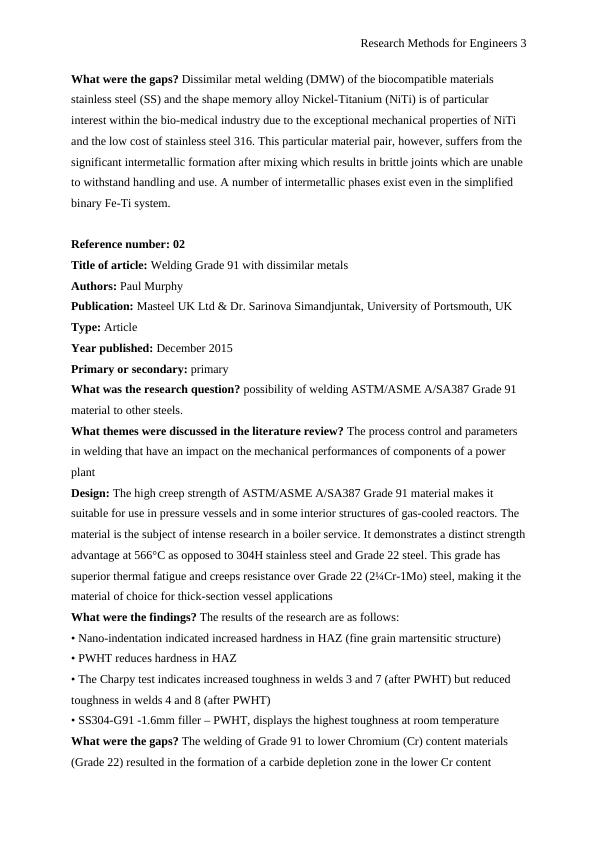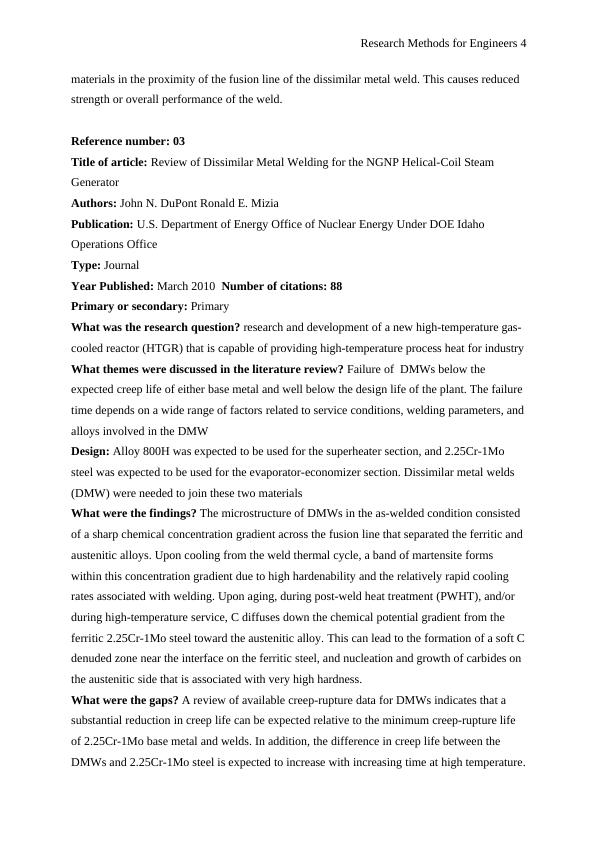Research Methods for Engineers Article 2022
Submit progress with Literature including Literature Planner, Mind Map, critical summary of research papers, and detailed citation.
13 Pages3801 Words11 Views
Added on 2022-10-06
Research Methods for Engineers Article 2022
Submit progress with Literature including Literature Planner, Mind Map, critical summary of research papers, and detailed citation.
Added on 2022-10-06
ShareRelated Documents
Research Methods for Engineers 1
RESEARCH METHODS FOR ENGINEERS
Student’s Name
Course
Professor’s Name
Institutional Affiliation
State/City
Date
RESEARCH METHODS FOR ENGINEERS
Student’s Name
Course
Professor’s Name
Institutional Affiliation
State/City
Date

Research Methods for Engineers 2
Literature Planner
Student Name: Student Number:
Topic: Developing a welding procedure for joining two dissimilar metals, a creep resistant
2.25Cr-1Mo steel and a type AISI310 stainless steel for high-temperature furnace application.
Reference number: 01
Title of article: Dissimilar Welding of Stainless Steel to Other Metals
Authors: B. I. Mendoza, Z. C. Maldonado, H. A. Albiter
Publication: N/A
Publication rating: N/A
Type: article
Year published: Jan-2017 number of citations: 5
Primary or secondary: Primary
What was the research question? To know the mechanical behavior of a dissimilar weld
between HSLA Steel and Super-duplex Stainless Steel (SDSS) to establish if the joint is
feasible or no
What themes were discussed in the literature review? Challenges of welding dissimilar
relate to the range of different properties displayed by the different materials and how these
effects the finished nature of the joint itself.
Design: The need for joining dissimilar metals has existed for a long time and has generally
been considered to be beyond state of the art. Dissimilar metals have different chemistries, so
they have different properties, such as melting temperatures. Many of these metals are alloys
or a mixture of several elements, all of which melt at different temperatures. Therefore, when
accomplishing a weld, it is virtually impossible to prevent a chemical change at the moment a
melt of the parent metals occurs.
What were the findings? It was found that the ER 25.10.4L filler metal provided the best
equilibrium between ferrite and austenite phase in the Super-duplex Stainless-Steel final
microstructure and a band of martensite in the HSLA steel final microstructure. The dissimilar
joint presented acceptable mechanical properties which are superior to the HSLA in the as-
received condition, but lower than the SDSS in the as-received condition, proving that the
filler metal was adequate.
Literature Planner
Student Name: Student Number:
Topic: Developing a welding procedure for joining two dissimilar metals, a creep resistant
2.25Cr-1Mo steel and a type AISI310 stainless steel for high-temperature furnace application.
Reference number: 01
Title of article: Dissimilar Welding of Stainless Steel to Other Metals
Authors: B. I. Mendoza, Z. C. Maldonado, H. A. Albiter
Publication: N/A
Publication rating: N/A
Type: article
Year published: Jan-2017 number of citations: 5
Primary or secondary: Primary
What was the research question? To know the mechanical behavior of a dissimilar weld
between HSLA Steel and Super-duplex Stainless Steel (SDSS) to establish if the joint is
feasible or no
What themes were discussed in the literature review? Challenges of welding dissimilar
relate to the range of different properties displayed by the different materials and how these
effects the finished nature of the joint itself.
Design: The need for joining dissimilar metals has existed for a long time and has generally
been considered to be beyond state of the art. Dissimilar metals have different chemistries, so
they have different properties, such as melting temperatures. Many of these metals are alloys
or a mixture of several elements, all of which melt at different temperatures. Therefore, when
accomplishing a weld, it is virtually impossible to prevent a chemical change at the moment a
melt of the parent metals occurs.
What were the findings? It was found that the ER 25.10.4L filler metal provided the best
equilibrium between ferrite and austenite phase in the Super-duplex Stainless-Steel final
microstructure and a band of martensite in the HSLA steel final microstructure. The dissimilar
joint presented acceptable mechanical properties which are superior to the HSLA in the as-
received condition, but lower than the SDSS in the as-received condition, proving that the
filler metal was adequate.

Research Methods for Engineers 3
What were the gaps? Dissimilar metal welding (DMW) of the biocompatible materials
stainless steel (SS) and the shape memory alloy Nickel-Titanium (NiTi) is of particular
interest within the bio-medical industry due to the exceptional mechanical properties of NiTi
and the low cost of stainless steel 316. This particular material pair, however, suffers from the
significant intermetallic formation after mixing which results in brittle joints which are unable
to withstand handling and use. A number of intermetallic phases exist even in the simplified
binary Fe-Ti system.
Reference number: 02
Title of article: Welding Grade 91 with dissimilar metals
Authors: Paul Murphy
Publication: Masteel UK Ltd & Dr. Sarinova Simandjuntak, University of Portsmouth, UK
Type: Article
Year published: December 2015
Primary or secondary: primary
What was the research question? possibility of welding ASTM/ASME A/SA387 Grade 91
material to other steels.
What themes were discussed in the literature review? The process control and parameters
in welding that have an impact on the mechanical performances of components of a power
plant
Design: The high creep strength of ASTM/ASME A/SA387 Grade 91 material makes it
suitable for use in pressure vessels and in some interior structures of gas-cooled reactors. The
material is the subject of intense research in a boiler service. It demonstrates a distinct strength
advantage at 566°C as opposed to 304H stainless steel and Grade 22 steel. This grade has
superior thermal fatigue and creeps resistance over Grade 22 (2¼Cr-1Mo) steel, making it the
material of choice for thick-section vessel applications
What were the findings? The results of the research are as follows:
• Nano-indentation indicated increased hardness in HAZ (fine grain martensitic structure)
• PWHT reduces hardness in HAZ
• The Charpy test indicates increased toughness in welds 3 and 7 (after PWHT) but reduced
toughness in welds 4 and 8 (after PWHT)
• SS304-G91 -1.6mm filler – PWHT, displays the highest toughness at room temperature
What were the gaps? The welding of Grade 91 to lower Chromium (Cr) content materials
(Grade 22) resulted in the formation of a carbide depletion zone in the lower Cr content
What were the gaps? Dissimilar metal welding (DMW) of the biocompatible materials
stainless steel (SS) and the shape memory alloy Nickel-Titanium (NiTi) is of particular
interest within the bio-medical industry due to the exceptional mechanical properties of NiTi
and the low cost of stainless steel 316. This particular material pair, however, suffers from the
significant intermetallic formation after mixing which results in brittle joints which are unable
to withstand handling and use. A number of intermetallic phases exist even in the simplified
binary Fe-Ti system.
Reference number: 02
Title of article: Welding Grade 91 with dissimilar metals
Authors: Paul Murphy
Publication: Masteel UK Ltd & Dr. Sarinova Simandjuntak, University of Portsmouth, UK
Type: Article
Year published: December 2015
Primary or secondary: primary
What was the research question? possibility of welding ASTM/ASME A/SA387 Grade 91
material to other steels.
What themes were discussed in the literature review? The process control and parameters
in welding that have an impact on the mechanical performances of components of a power
plant
Design: The high creep strength of ASTM/ASME A/SA387 Grade 91 material makes it
suitable for use in pressure vessels and in some interior structures of gas-cooled reactors. The
material is the subject of intense research in a boiler service. It demonstrates a distinct strength
advantage at 566°C as opposed to 304H stainless steel and Grade 22 steel. This grade has
superior thermal fatigue and creeps resistance over Grade 22 (2¼Cr-1Mo) steel, making it the
material of choice for thick-section vessel applications
What were the findings? The results of the research are as follows:
• Nano-indentation indicated increased hardness in HAZ (fine grain martensitic structure)
• PWHT reduces hardness in HAZ
• The Charpy test indicates increased toughness in welds 3 and 7 (after PWHT) but reduced
toughness in welds 4 and 8 (after PWHT)
• SS304-G91 -1.6mm filler – PWHT, displays the highest toughness at room temperature
What were the gaps? The welding of Grade 91 to lower Chromium (Cr) content materials
(Grade 22) resulted in the formation of a carbide depletion zone in the lower Cr content

Research Methods for Engineers 4
materials in the proximity of the fusion line of the dissimilar metal weld. This causes reduced
strength or overall performance of the weld.
Reference number: 03
Title of article: Review of Dissimilar Metal Welding for the NGNP Helical-Coil Steam
Generator
Authors: John N. DuPont Ronald E. Mizia
Publication: U.S. Department of Energy Office of Nuclear Energy Under DOE Idaho
Operations Office
Type: Journal
Year Published: March 2010 Number of citations: 88
Primary or secondary: Primary
What was the research question? research and development of a new high-temperature gas-
cooled reactor (HTGR) that is capable of providing high-temperature process heat for industry
What themes were discussed in the literature review? Failure of DMWs below the
expected creep life of either base metal and well below the design life of the plant. The failure
time depends on a wide range of factors related to service conditions, welding parameters, and
alloys involved in the DMW
Design: Alloy 800H was expected to be used for the superheater section, and 2.25Cr-1Mo
steel was expected to be used for the evaporator-economizer section. Dissimilar metal welds
(DMW) were needed to join these two materials
What were the findings? The microstructure of DMWs in the as-welded condition consisted
of a sharp chemical concentration gradient across the fusion line that separated the ferritic and
austenitic alloys. Upon cooling from the weld thermal cycle, a band of martensite forms
within this concentration gradient due to high hardenability and the relatively rapid cooling
rates associated with welding. Upon aging, during post-weld heat treatment (PWHT), and/or
during high-temperature service, C diffuses down the chemical potential gradient from the
ferritic 2.25Cr-1Mo steel toward the austenitic alloy. This can lead to the formation of a soft C
denuded zone near the interface on the ferritic steel, and nucleation and growth of carbides on
the austenitic side that is associated with very high hardness.
What were the gaps? A review of available creep-rupture data for DMWs indicates that a
substantial reduction in creep life can be expected relative to the minimum creep-rupture life
of 2.25Cr-1Mo base metal and welds. In addition, the difference in creep life between the
DMWs and 2.25Cr-1Mo steel is expected to increase with increasing time at high temperature.
materials in the proximity of the fusion line of the dissimilar metal weld. This causes reduced
strength or overall performance of the weld.
Reference number: 03
Title of article: Review of Dissimilar Metal Welding for the NGNP Helical-Coil Steam
Generator
Authors: John N. DuPont Ronald E. Mizia
Publication: U.S. Department of Energy Office of Nuclear Energy Under DOE Idaho
Operations Office
Type: Journal
Year Published: March 2010 Number of citations: 88
Primary or secondary: Primary
What was the research question? research and development of a new high-temperature gas-
cooled reactor (HTGR) that is capable of providing high-temperature process heat for industry
What themes were discussed in the literature review? Failure of DMWs below the
expected creep life of either base metal and well below the design life of the plant. The failure
time depends on a wide range of factors related to service conditions, welding parameters, and
alloys involved in the DMW
Design: Alloy 800H was expected to be used for the superheater section, and 2.25Cr-1Mo
steel was expected to be used for the evaporator-economizer section. Dissimilar metal welds
(DMW) were needed to join these two materials
What were the findings? The microstructure of DMWs in the as-welded condition consisted
of a sharp chemical concentration gradient across the fusion line that separated the ferritic and
austenitic alloys. Upon cooling from the weld thermal cycle, a band of martensite forms
within this concentration gradient due to high hardenability and the relatively rapid cooling
rates associated with welding. Upon aging, during post-weld heat treatment (PWHT), and/or
during high-temperature service, C diffuses down the chemical potential gradient from the
ferritic 2.25Cr-1Mo steel toward the austenitic alloy. This can lead to the formation of a soft C
denuded zone near the interface on the ferritic steel, and nucleation and growth of carbides on
the austenitic side that is associated with very high hardness.
What were the gaps? A review of available creep-rupture data for DMWs indicates that a
substantial reduction in creep life can be expected relative to the minimum creep-rupture life
of 2.25Cr-1Mo base metal and welds. In addition, the difference in creep life between the
DMWs and 2.25Cr-1Mo steel is expected to increase with increasing time at high temperature.

End of preview
Want to access all the pages? Upload your documents or become a member.
Related Documents
Assignment On Literature Plannerlg...
|5
|1601
|31
